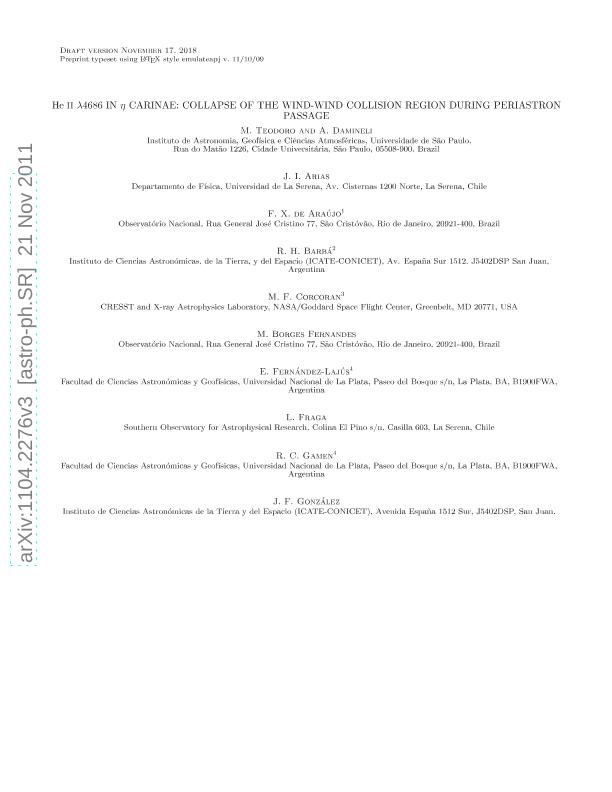Artículo
He II lambda4686 in Eta Carinae: Collapse of the Wind-Wind Collision Region during Periastron Passage
Teodoro, M.; Damineli, A.; Arias, J. I.; de Araújo, F. X.; Barba, Rodolfo Hector ; Corcoran, Michael; Borges Fernandes, M.; Fernandez Lajus, Eduardo Eusebio
; Corcoran, Michael; Borges Fernandes, M.; Fernandez Lajus, Eduardo Eusebio ; Fraga, L.; Gamen, Roberto Claudio
; Fraga, L.; Gamen, Roberto Claudio ; Gonzalez, Jorge Federico
; Gonzalez, Jorge Federico ; Groh, J. H.; Marshall, J. L.; McGregor, P. J.; Morrell, N.; Nicholls, D. C.; Parkin, E. R.; Pereira, C. B.; Phillips, M. M.; Solivella, Gladys Rebeca; Steiner, J. E.; Stritzinger, M.; Thompson, I.; Torres, C. A. O.; Torres, M. A. P.; Zevallos Herencia, M. I.
; Groh, J. H.; Marshall, J. L.; McGregor, P. J.; Morrell, N.; Nicholls, D. C.; Parkin, E. R.; Pereira, C. B.; Phillips, M. M.; Solivella, Gladys Rebeca; Steiner, J. E.; Stritzinger, M.; Thompson, I.; Torres, C. A. O.; Torres, M. A. P.; Zevallos Herencia, M. I.
 ; Corcoran, Michael; Borges Fernandes, M.; Fernandez Lajus, Eduardo Eusebio
; Corcoran, Michael; Borges Fernandes, M.; Fernandez Lajus, Eduardo Eusebio ; Fraga, L.; Gamen, Roberto Claudio
; Fraga, L.; Gamen, Roberto Claudio ; Gonzalez, Jorge Federico
; Gonzalez, Jorge Federico ; Groh, J. H.; Marshall, J. L.; McGregor, P. J.; Morrell, N.; Nicholls, D. C.; Parkin, E. R.; Pereira, C. B.; Phillips, M. M.; Solivella, Gladys Rebeca; Steiner, J. E.; Stritzinger, M.; Thompson, I.; Torres, C. A. O.; Torres, M. A. P.; Zevallos Herencia, M. I.
; Groh, J. H.; Marshall, J. L.; McGregor, P. J.; Morrell, N.; Nicholls, D. C.; Parkin, E. R.; Pereira, C. B.; Phillips, M. M.; Solivella, Gladys Rebeca; Steiner, J. E.; Stritzinger, M.; Thompson, I.; Torres, C. A. O.; Torres, M. A. P.; Zevallos Herencia, M. I.
Fecha de publicación:
10/02/2012
Editorial:
IOP Publishing
Revista:
Astrophysical Journal
ISSN:
0004-637X
Idioma:
Inglés
Tipo de recurso:
Artículo publicado
Clasificación temática:
Resumen
The periodic spectroscopic events in η Carinae are now well established and occur near the periastron passage of two massive stars in a very eccentric orbit. Several mechanisms have been proposed to explain the variations of different spectral features, such as an eclipse by the wind-wind collision (WWC) boundary, a shell ejection from the primary star or accretion of its wind onto the secondary. All of them have problems explaining all the observed phenomena. To better understand the nature of the cyclic events, we performed a dense monitoring of η Carinae with five Southern telescopes during the 2009 low-excitation event, resulting in a set of data of unprecedented quality and sampling. The intrinsic luminosity of the He II λ4686 emission line (L 310 L) just before periastron reveals the presence of a very luminous transient source of extreme UV radiation emitted in the WWC region. Clumps in the primary's wind probably explain the flare-like behavior of both the X-ray and He II λ4686 light curves. After a short-lived minimum, He II λ4686 emission rises again to a new maximum, when X-rays are still absent or very weak. We interpret this as a collapse of the WWC onto the "surface" of the secondary star, switching off the hard X-ray source and diminishing the WWC shock cone. The recovery from this state is controlled by the momentum balance between the secondary's wind and the clumps in the primary's wind.
Archivos asociados
Licencia
Identificadores
Colecciones
Articulos(IALP)
Articulos de INST.DE ASTROFISICA LA PLATA
Articulos de INST.DE ASTROFISICA LA PLATA
Articulos(ICATE)
Articulos de INST.D/CS ASTRONOMICAS D/LA TIERRA Y DEL ESPACIO
Articulos de INST.D/CS ASTRONOMICAS D/LA TIERRA Y DEL ESPACIO
Citación
Teodoro, M.; Damineli, A.; Arias, J. I.; de Araújo, F. X.; Barba, Rodolfo Hector; et al.; He II lambda4686 in Eta Carinae: Collapse of the Wind-Wind Collision Region during Periastron Passage; IOP Publishing; Astrophysical Journal; 746; 1; 10-2-2012; 1-15
Compartir
Altmétricas



